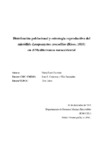Please use this identifier to cite or link to this item:
https://accedacris.ulpgc.es/handle/10553/75606
| Title: | Distribución poblacional y estrategia reproductiva del mictófido "Lampanyctus crocodilus" (Risso, 1810) en el Mediterráneo noroccidental | Authors: | Peiró Expósito, María | Director: | Calvo Costa, Eva Batista Company, Joan Fernández-Arcaya, Ulla |
UNESCO Clasification: | 251001 Oceanografía biológica 310510 Dinámica de las poblaciones |
Keywords: | Lampanyctus crocodilus Mar Mediterráneo |
Issue Date: | 2013 | Project: | RECS (2003-2004) PROMETEO (2008-2009) |
Abstract: | One of the most abundant fish spec1es m the Mediterranean Sea is the Myctophidae Lampanyctus crocodilus. Here we show a study based on 1717 specimens collected on the northwestem Mediterranean Sea, specifically in the Blanes submarine canyon. The data were collected by means of a series of otter trawl surveys in 17 oceanographic crnises of the RECS (2003-2004) and PRO:METEO (2008-2009) scientific projects. Bathymetric distribution of the species lies between 300 and 1500 m depth with a maximum abundauce between 300-700 m. L. crocodilus shows a peak of recrnitment during the summer months. Sex ratio is higher for females in summer and autumn and at depths of 800 m. The abtmdance was higher during spring season falling in successive months, coinciding with the seasonal evolution of the gonadosomatic index. The presence of mature females spans from spring to summer and show group synchronous organization ofthe ovary. Una de las especies más abundante de la familia Mytophidae en el Mar Mediterráneo es Lampanyctus crocodilus. El estudio está basado en 1717 especímenes obtenidos en la zona noroeste del Mar Mediterráneo, más específicamente en el cañón submarino de Blanes. Los datos se recogieron durate las 17 campañas oceanográficas de los proyectos científicos RECS (años 2003-2004) y PROMETEO (años 2008-2009). La distribución batimétrica de la especie se encuentra entre 300 y 1500m de profundidad con una mayor abundancia entre 300 y 700m. L.crocodrilus muestra máximos de reclutamiento durante los meses de verano. La sex-ratio es elevada en primavera decayendo en los meses sucesivos, coincidiendo con la progresión del índice gonadosomático (IGS). La presencia de hembras maduras es máxima entre las estaciones de primavera y verano, y presentan una organización del ovario sincrónica por grupos. |
Department: | Departamento de Biología | Faculty: | Facultad de Ciencias del Mar | Degree: | Máster Universitario en Oceanografía | URI: | https://accedacris.ulpgc.es/handle/10553/75606 |
| Appears in Collections: | Trabajo final de máster Restringido ULPGC |
En el caso de que no encuentre el documento puede ser debido a que el centro o las/os autoras/es no autorizan su publicación. Si tiene verdadero interés en el contenido del mismo, puede dirigirse al director/a o directores/as del trabajo cuyos datos encontrará más arriba.
Show full item recordPage view(s)
81
checked on May 18, 2024
Download(s)
9
checked on May 18, 2024
Google ScholarTM
Check
Share
Export metadata
Items in accedaCRIS are protected by copyright, with all rights reserved, unless otherwise indicated.
